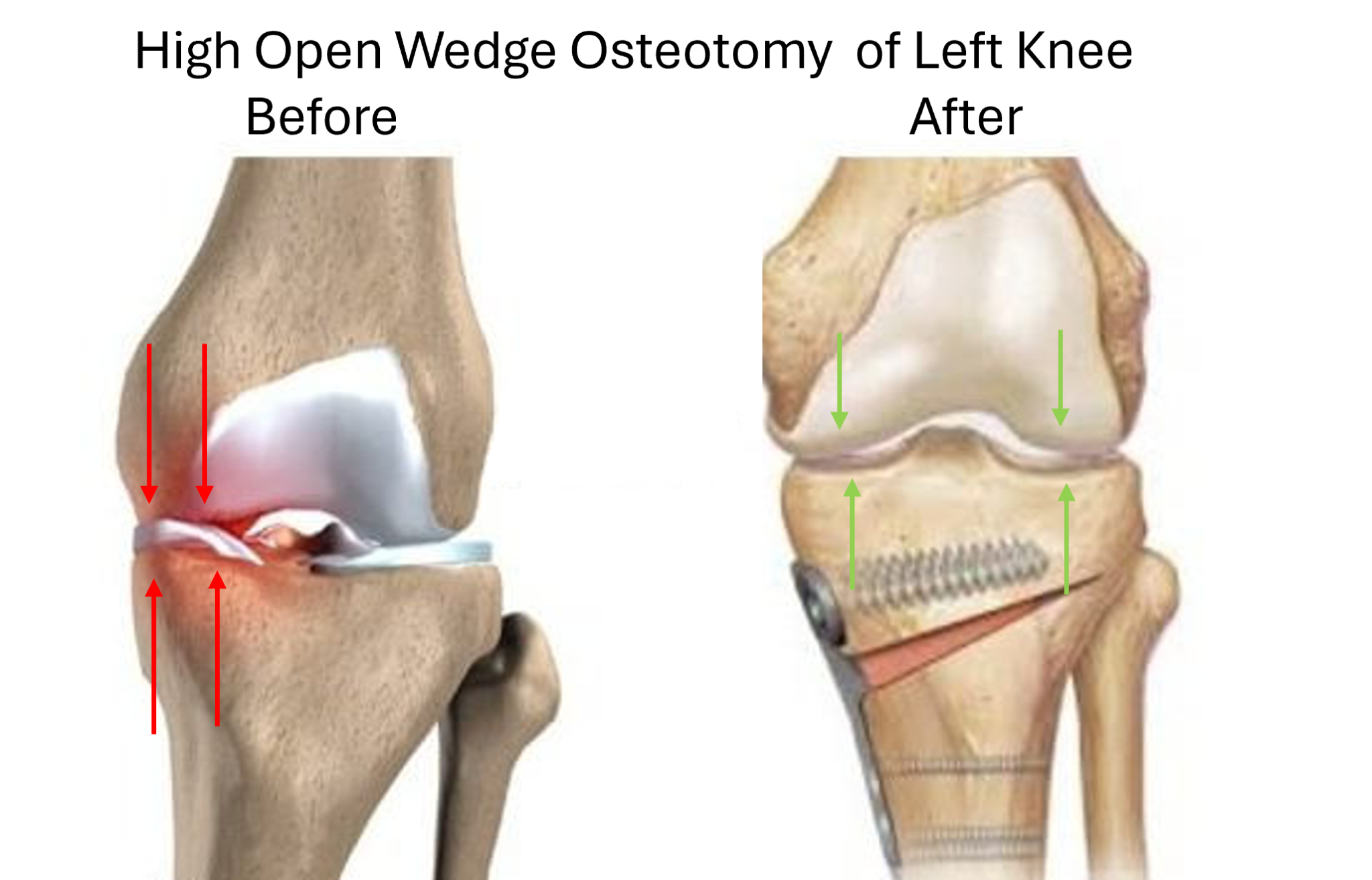High Tibial Osteotomy
If you have worsening pain from your knee arthritis but you still feel too young, too active and independent to consider total or partial knee replacement, then a high tibial osteotomy (HTO) might be the right solution for you.
HTO has a very good effect on the pain whilst allows patients to enjoy a more natural feeling in their knee during their daily and recreational activities. HTO can delay the need for total knee replacement for another 10 years or more.
HTO is a simple surgical procedure where the surgeon carefully cuts (breaks) the tibia( shin bone) just below the knee, re-aligns it in order to relieve the pressure from the inner half of the knee joint just above, and then fixes the bone in its new position with an orthopaedic metal plate and screws.

How HTO works
When the alignment of the leg is not balanced more loading goes through the knee with every step and this progressively causes increased wear and tear ( and pain) in the affected half of the knee.
When there is varus deformity (bow legs) the inner half of the knee (medial compartment) is mostly affected. When there is knocked knees (valgus knee deformity, less common) a , the outer half (lateral compartment) of the knee suffers the most.
Sometimes, there is only subtle deformity (too subtle to be noticed by the patient) but still enough to cause imbalanced loading distribution through the knee. Appropriate long standing of the legs allow the surgeon to measure and assess the orientation of the mechanical axis of the legs. With HTO the alignment (mechanical axis) is corrected and the loading is distributed again symmetrically through the different compartments of the knee.
This correction relieves the pain from the affected compartment. Studies show that the pain is reduced significantly and this effect last upt to 10 years, sometimes more. The main advantage over knee replacements is that it gives a more natural feeling in the knee.
Can I walk after surgery? What about recovery?
After the surgery you will walk immediately with crutches or a stick and with partial weight bearing on the operated leg for approximately 6 weeks. You will need to do leg exerccises daily and attend a supervised physiotherapy session at least once per week. After the six week period, you will be gradually allowed to walk unassisted and with full weight bearing.
What is better? HTO or UNI (partial) knee replacement?
It depends on the condition of the knee, the body weight of the patient and their lifestyle. With appropriate patient selection they both have a comparable outcome in terms of pain control, knee function as well as survivorship. HTO provides a more natural sensation of having your own, native knee joint which is related with normal proprioception and better patient satisfaction. Conversion of the HTO to TKR when the time comes might also be a bit easier to perform than converting a UNI knee replacement to a total knee replacement.
How long do I need to stay at the hospital?
The operation is done under general or regional spinal anaesthesia; this is the anaesthetist’s call but if you have any preference they are happy to go with it, if there aren’t any contraindications. You will be admitted to the hospital in the morning of the date of surgery and you will be discharged in the same evening or next morning.
What are the risks?
At Athens BJR Center we abide by the UK GMC (General Medical Council) Guidelines about discussing the outocome, technique, risks and complications of any proposed intervention during the informed consent process. HTO is a procedure of moderate severity. Common surgical risks in orthopaedic surgery (and in HTO) are the following:
Infection
After surgery an infection may occur in the skin over the wound or deep in the wound. An infection may happen while you are in the hospital or after you go home. You will be given antibiotics before the start of your surgery and these will be continued for about 24 hours afterward to prevent infection.
Deep infection happens in around 1% of the cases. It is rather rare but when it happens it usually requires further surgeries and long term antibiotics for 6 weeks.
Thromboembolism (blood clots)
Blood clots in the leg veins rarely happens after any orthopaedic surgery in the legs. Clinically important thrombosis occurs in around 2% of the cases. Blood clots can form in the deep veins of the legs or pelvis after surgery. Blood thinners such as low-molecular-weight heparin, rivaroxaban or aspirin can help prevent this problem. Newer blood thinners, such as apixaban (Eliquis) and rivaroxaban (Xarelto), may also be prescribed by depending upon your needs.
Injury to nerve or vessels
Although it rarely happens, nerves or blood vessels may be injured or stretched during the procedure. Some small nerv branches to the skin will be inadvertedly cut and this may create an area of numbness around the skin incision. This doesn’t cause any functional problem or discomfort to the patient.





